4 Promising Programs to Practice Pronunciation in Private
For many students, pronunciation is an elusive white whale. They can often get the basics down, but they rarely get enough time and feedback to fine tune their dipthongs or their consonant clusters. Pronunciation classes are wonderful, but often in short supply, and of course if you’re in a mixed learner setting, one group of students may have no issues at all where another group struggles endlessly.
Luckily, the growth of edtech, artificial intelligence, and voice recognition software now allow students to practice their pronunciation without waiting for their next classes or guessing at whether the way they said something in a choral response is actually the right way to say it.
There are a growing number of apps and services out there that can allow students to speak, check their pronunciation, and refine it, all without relying on teachers or native English speakers to guide them.
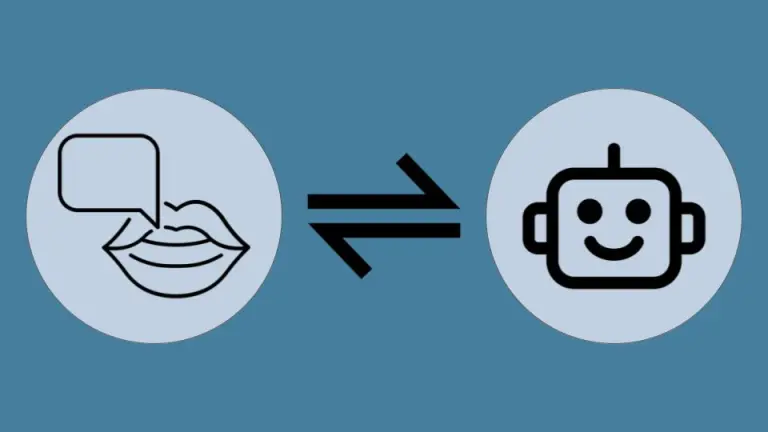
1. Google Search
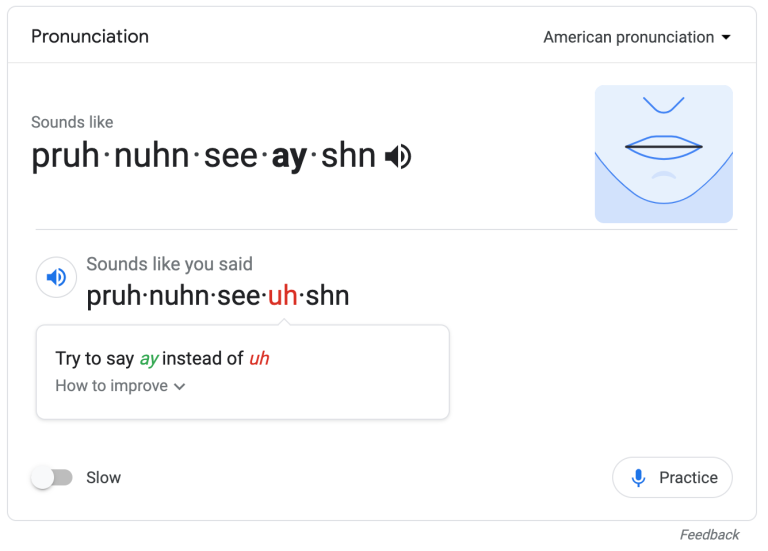
Google’s Pronunciation Cards provide quick and easy feedback.
The first place I tell my students to go to check their own pronunciation is the easiest, too: Google Search. Many teachers and students are unaware that if you simply type “Pronounce + WORD” into the search bar, Google will bring up a simple card with a breakdown of the word by syllable. Not only that, but it will play a simple animation showing a mouth and tongue, helping students see how they should be moving their muscles to achieve the desired sounds. There’s also an option to slow down the audio and video playback to make sure all the details are being caught.
The best part, though, is hidden one click deeper. When students tap on the “Practice” button in the lower right corner, Google will let them talk, and then it will give basic feedback on the quality of the pronunciation. Mispronounced sections will be highlighted with tips on how to pronounce each missed sound. This allows students to spend as much time as they need working on each sound on their own.
2. Google Docs Voice Typing
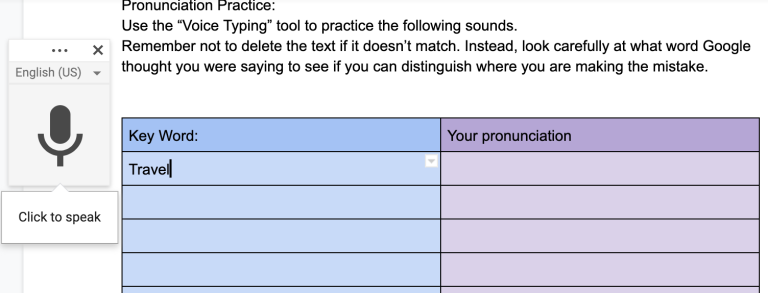
Use Voice Typing in Google Docs to practice words, phrases, or entire monologues.
Continuing with the same technology, Google Docs has a built-in dictation tool called Voice Typing. This technology is built for those who prefer or have need to talk rather than type, but I’ve found it’s a great way to get my students working on their pronunciation.
Inside of Google Docs, simply click on “Tools> Voice Typing” and as long as there’s a microphone in the computer, students are good to go.
Of course, to really get things going, you can build documents that help them work on specific sounds, similar sentences, and minimal pairs. Here’s a document that I’ve made which allows the teacher to put text in the blue cells of a table and encourages students to try to replicate the word through speaking in the purple boxes. Students simply look at the words or phrases in blue and then tap into the corresponding purple box. When they’re ready, They can click the voice typing microphone and give it a try.
3. Forvo
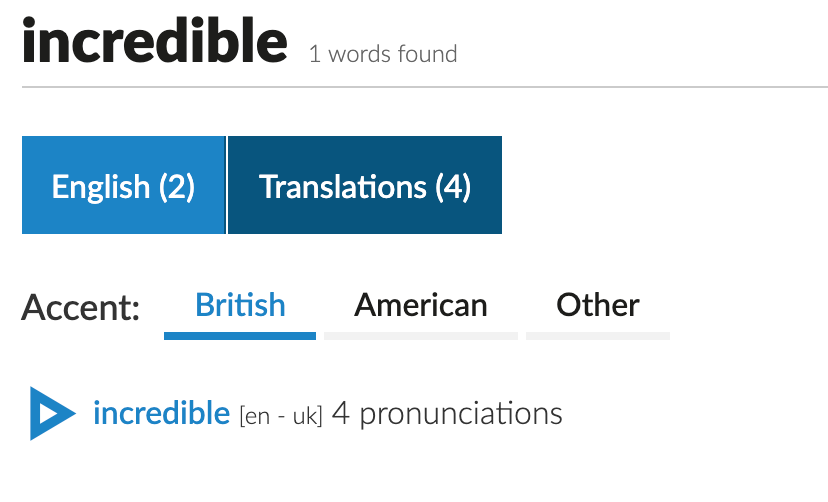
Forvo’s user-generated database of pronunciation lets people hear the real way people talk.
Forvo is a pronunciation dictionary for the world. In Forvo, students can type in the word they are looking for, and then choose from a number of real-life pronunciations, including British English, American English, and “Other.” Regular people from around the world can submit their pronunciation, so there are options for students to hear a variety of accents, allowing them to broaden their listening and hopefully reduce accent bias.
While Forvo doesn’t give students direct feedback like the other services mentioned here, I love the fact that there are real people submitting and sharing their unique accents. Another potential problem here is that Forvo still needs development and more people using and submitting to it. I found a number of words that only have an American pronunciation or only have a British pronunciation, so I’d love to see a deeper collection in the future.
4. ELSA
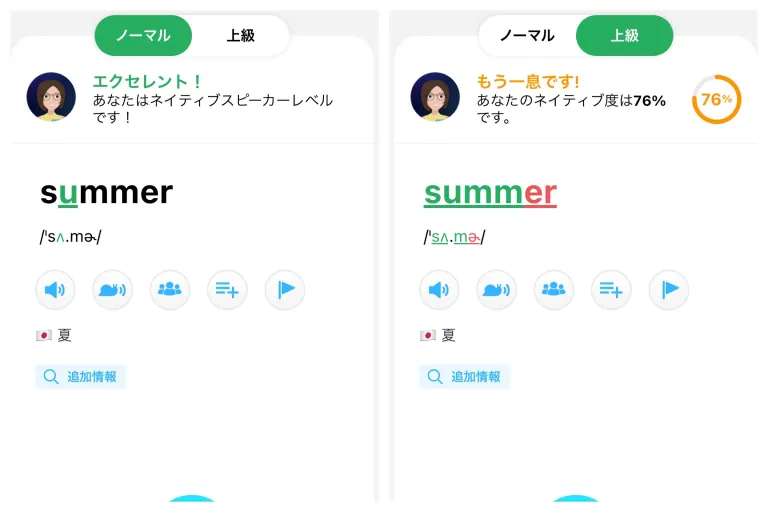
ELSA gives varying feedback depending on your chosen level.
If you liked the Google Search options, think of ELSA like that program on steroids. This incredibly robust app isn’t free, but dang have they put some work into it. ELSA also uses AI to evaluate and give feedback on pronunciation, but it starts with asking the user to identify their native language and begins by focusing on pronunciation issues that are unique to that language group.
But that’s only the beginning. From there, ELSA lets learners choose whether they are beginners, intermediate, or advanced, and then uses that to determine how critical to be. As learners go through words and phrases, it lets them see how well they’re doing at the “normal” pronunciation for the chosen level, and also allows for a challenge to see how they’re doing at a higher level. Here, learners might get an encouraging “Excellent!” for the individual skill they’re working on, and a “Let’s try again” if they push their challenge to expand to surrounding sounds.
On top of all of this, ELSA is gamified, giving students the chance to build up to higher levels, face new challenges, and of course get those dopamine-inducing bings and confetti explosions.
The biggest drawback to ELSA is its price. Like many apps, it runs on a subscription model, and currently starts at US$109 a year. However, with only a few clicks and running a few sample lessons, I quickly found that it was willing to offer discounts of up to 65%, immediately bringing it down to US$38, which is much more reasonable, but may still be out of many learners’ price range. As always, pricing structures on apps are prone to change, so make sure to encourage students to do some digging before committing.
Technologies like these allow students to build on their skills from the privacy of their own home in ways that were never even imagined just a few short years ago. There are inevitable problems, and these programs certainly prioritize one accent over another, but students can learn and understand those issues as they grow.
These apps and programs are only getting smarter and more accessible, and I expect more and more to show up in the future. As you find other useful services, please be sure to share them in the comments below—I’d love to hear from you and keep my eye on what’s coming around the bend!

